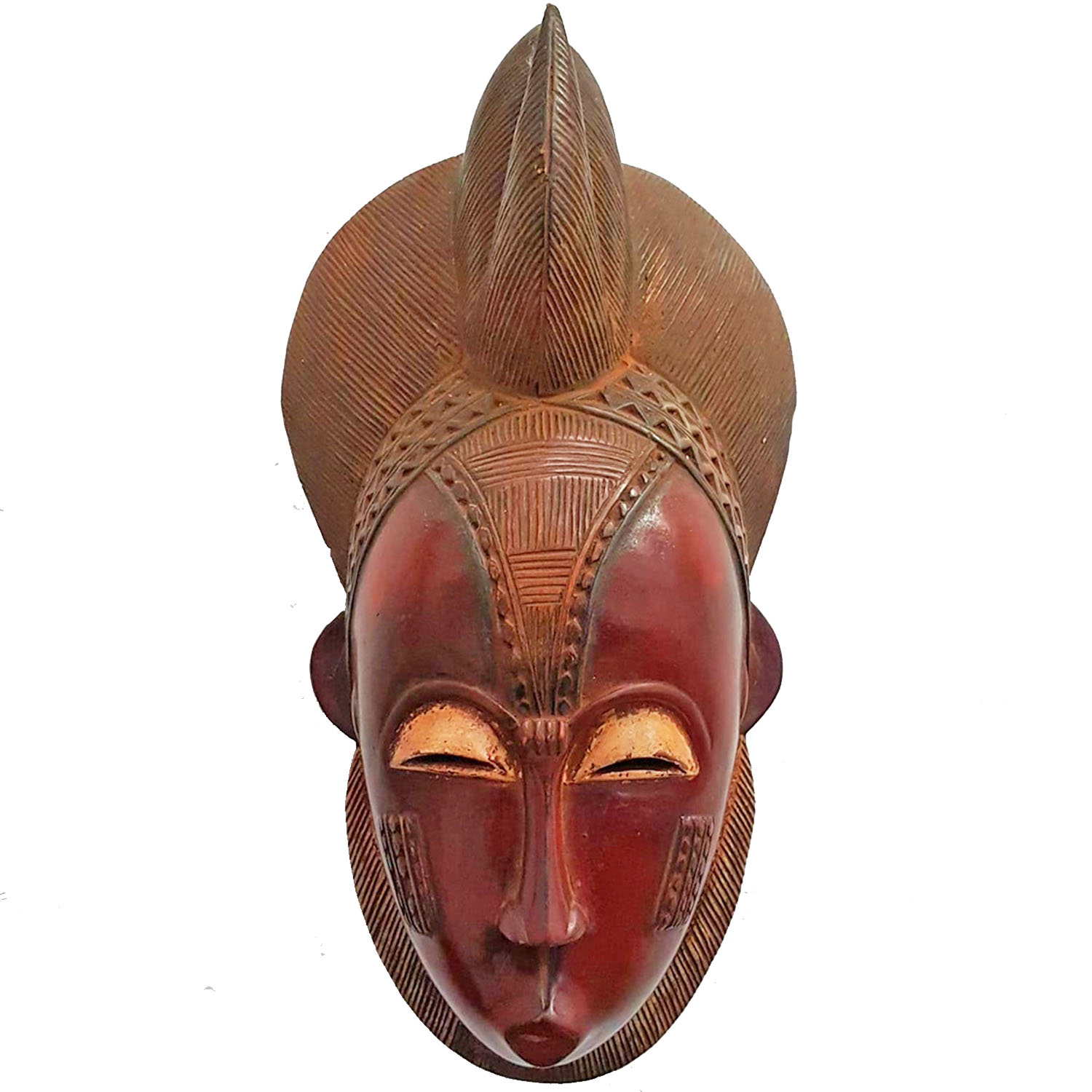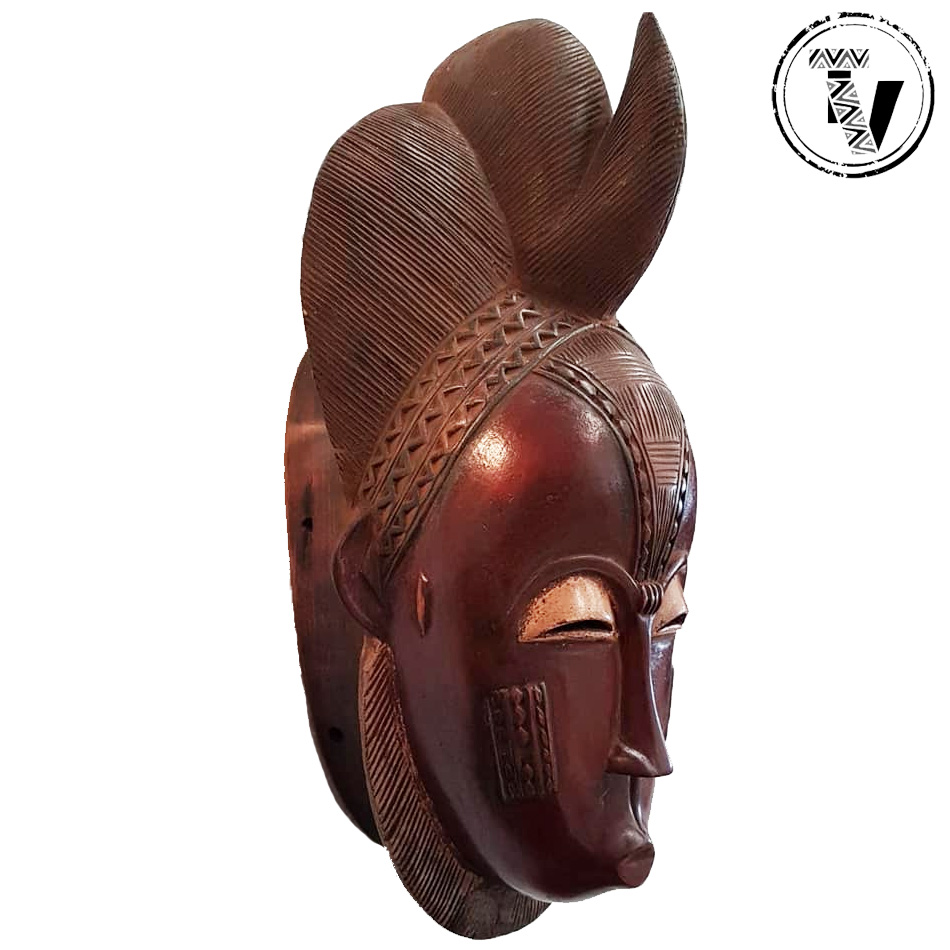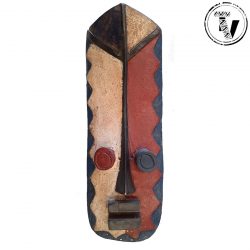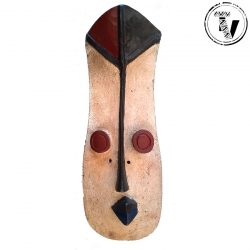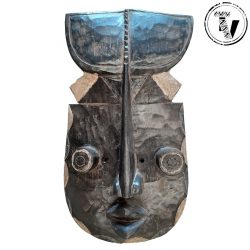Description
Baule Mblo Portrait Mask
The Baule people is one of the largest ethnic group in the Côte d’Ivoire. They have played a central role in the twentieth-century history of the country. They waged the longest war of resistance to French colonization of any West African people and maintained their traditional objects and beliefs longer than many groups in such constant contact with European administrators, traders, and missionaries. The Baule belong to the Akan peoples who inhabit Ghana and Côte d’Ivoire. According to a legend, during the eighteenth century, the queen, Abla Poku, had to lead her people west to the shores of the Comoe, the land of Senufo. In order to cross the river, she sacrificed her own son. This sacrifice was the origin of the name Baule, for baouli means “the child has died.” Now about one million Baule occupy a part of the eastern Côte d’Ivoire between the Komoé and Bandama rivers that is both forest and savanna land. Baule society was characterized by extreme individualism, great tolerance, a deep aversion toward rigid political structures, and a lack of age classes, initiation, circumcision, priests, secret societies, or associations with hierarchical levels. Each village was independent of the others and made its own decisions under the presiding presence of a council of elders. Everyone participated in discussions, including slaves. It was an egalitarian society. The Baule compact villages are divided into wards, or quarters, and subdivided into family compounds of rectangular dwellings arranged around a courtyard; the compounds are usually aligned on either side of the main village street.
The Baule are agriculturists; yams and maize are the staples, supplemented by fish and game; coffee, cocoa and kola nuts are major cash crops. The importance of the yam is demonstrated in an annual harvest festival in which the first yam is symbolically offered to the ancestors, whose worship is a prominent aspect of Baule religion. Ancestors are the object of worship but are not depicted. The foundation of Baule’s social and political institutions is the matrilineal lineage; each lineage has ceremonial stools that embody ancestral spirits. Paternal descent is recognized, however, and certain spiritual and personal qualities are believed to be inherited through it. The Baule believe in an intangible and inaccessible creator god, Nyamien. Asie, the god of the earth, controls humans and animals. The spirits, or amuen, are endowed with supernatural powers. Religion is founded upon the idea of the immortality of the soul.
Baule art is sophisticated and stylistically diverse. Non-inherited, the sculptor’s profession is the result of a personal choice. The Baule have types of sculpture that none of the other Akan peoples possess. Wooden sculptures and masks allow closer contact with the supernatural world. Baule statues are usually standing on a base with legs slightly bent, with their hands resting on their abdomen in a gesture of peace, and their elongated necks supporting a face with typically raised scarification and bulging eyes. The coiffure is always very detailed and is usually divided into plaits. Baule figures answer to two types of devotion: one depicts the “spiritual” spouse who, in order to be appeased, requires the creation of a shrine in the personal hut of the individual. A man will own his spouse, the blolo bian, and a woman her spouse, the blolo bla. The Baule believes that before they were born into the world they existed in a spirit world, where each one had a mate. Sometimes that spirit mate becomes jealous of their earthly mate and causes marital discord. When this happens, a figure depicting the other world spouse is carved and placated with earthly signs of attention.
The Baule are also noted for their fine wooden sculpture, particularly for their ritual figures representing spirits; these are associated with the ancestor cult. The Baule have also created monkey figures gbekre that more or less resemble each other. Endowed with prognathic jaw and sharp teeth and a granular patina resulting from sacrifices, the monkey holds a bowl or a pestle in its paws. Sources differ on its role or function: some say it intervenes in the ritual of divination, others that it is a protection against sorcerers, or a protective divinity of agrarian rites, or a bush spirit. The figures and human masks are elegant — well polished, with elaborate hairdressings and scarification.
Masks correspond to several types of dances: the gba gba, the bonu amuen, the mblo and the goli. They never represent their ancestors and are always worn by men. The gba gba is used at the funerals of women during the harvest season. It celebrates beauty and age, hence its refined features. The double mask represents the marriage of the sun and the moon or twins, whose birth is always a good sign. The bonu amuen protects the village from external threats; it obliges the woman to a certain discipline, and it appears at the commemorations of the death of notables. When they intervene in the life of the community, they take the shape of a wooden helmet that represents a buffalo or antelope and which is worn with a raffia costume and metal ankle bracelets; the muzzle has teeth, which incarnate the fierce animal that is to defend the group.
Mblo is the name of a performance category that uses face masks in skits and solo dances. Mblo masks, used in entertainment dances are one of the oldest of Baule art forms. These refined human face masks are usually portraits of particular known individuals. Mblo masks embody the core Baule sculpture style manifested in figures and decorated objects – spoons, combs, pulleys and the like. Lustrous curving surfaces, suggesting clean, healthy, well-fed skin, are set off by delicately textured zones representing coiffures, scarifications, and other ornaments. The idealized faces are introspective, with the high foreheads and the large downcast eyes. Ornaments above the face – birds, combs, horns, faces, and other decorative motifs – are chosen for their beauty, and have no iconographic significance. Fine scarifications and coiffures denote personal beauty, refinement and a desire to give pleasure to others.
Goli is the day-long spectacle that normally involves the whole village and includes the appearance of four pairs of masks, music played on special instruments, and, ideally, the joyous consumption of a great deal of palm wine. Goli can be performed both as an entertainment and for the funeral of important men. The very characteristic, round-shaped “lunar” goli is surmounted by two horns. It was borrowed from the Wan for a celebration adopted by the Baule after 1900. Celebrating peace and joy, they would sing, dance, and drink palm wine. In the procession, the goli preceded the four groups of dancers, representing young adolescents. The goli would be used on the occasion of the new harvest, the visit of dignitaries, or at the funerals of notables. Boxes for the mouse oracle (in which sticks are disturbed by a live mouse, to give the augury) are unique to the Baule, whose carvers also produce heddle pulleys, combs, hairpins, and gong mallets.


